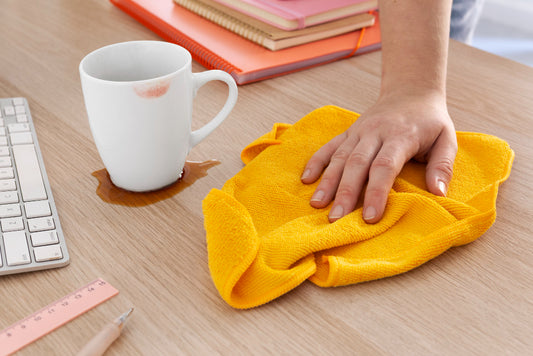In the world of cleaning tools, the humble mop stands as an unsung hero, tirelessly working to maintain cleanliness in homes, offices, and industrial spaces. However, the journey from raw materials to a reliable cleaning companion involves a meticulous manufacturing process. In this in-depth exploration, we will uncover the behind-the-scenes magic of crafting quality cleaning mops, shedding light on the manufacturing intricacies that ensure these essential tools meet the highest standards of performance and durability.
1. Raw Materials Selection:
High-Quality Fibers:
- The journey of crafting a quality cleaning mop begins with the selection of raw materials. High-quality mop fibers are essential for effective cleaning. Microfiber, cotton, or a blend of materials are commonly chosen for their absorbent and durable properties.
Sturdy Handles and Frames:
- The mop's handle and frame, the structural backbone of the cleaning tool, are crafted from materials like aluminum, steel, or durable plastics. The choice of material depends on factors such as weight, durability, and compatibility with various cleaning tasks.
2. Design and Prototyping:
Ergonomic Considerations:
- Before mass production begins, designers focus on creating an ergonomic and user-friendly mop design. Considerations include handle grip comfort, the weight distribution of the mop head, and the overall maneuverability of the tool.
Prototyping for Testing:
- Prototypes are crafted to test the design in real-world scenarios. These prototypes undergo rigorous testing to ensure that the mop's structure, handle, and mop head function seamlessly together. Feedback from testing is used to refine the design further.
3. Yarn Spinning for Cotton Mops:
Cotton Mop Preparation:
- For cotton mop heads, the manufacturing process involves yarn spinning. Cotton fibers are spun into yarn, creating the base material for the mop head. The spinning process ensures uniformity and strength in the yarn, essential for durability during cleaning tasks.
Blending for Microfiber Mops:
- In the case of microfiber mops, a blend of synthetic materials such as polyester and polyamide is carefully combined to create microfiber strands. These strands are known for their exceptional absorption capabilities and durability.
4. Mop Head Assembly:
Securing the Yarn or Microfiber Strands:
- The next step involves securing the yarn or microfiber strands to the mop frame. This can be achieved through various methods, including stitching, weaving, or the use of advanced technologies like ultrasonic bonding. The goal is to create a secure and long-lasting bond between the mop head and frame.
Ensuring Even Distribution:
- During assembly, manufacturers pay attention to the even distribution of mop fibers across the mop head. This ensures consistent cleaning performance and prevents uneven wear over time.
5. Handle Attachment:
Secure Attachment Points:
- Attaching the mop handle to the frame requires precision to ensure a secure connection. Manufacturers employ methods such as screwing, snapping, or clamping to create a reliable attachment point. This step is crucial for the overall stability and durability of the mop.
Adjustable Handles:
- Many mops are designed with adjustable handles to cater to users of varying heights. This feature enhances user comfort and contributes to the mop's versatility in different cleaning scenarios.
6. Quality Control Inspections:
Visual Checks:
- Before moving forward in the manufacturing process, quality control inspections are conducted. Visual checks ensure that the mop's components meet design specifications, and there are no defects or irregularities in the construction.
Functional Testing:
- Mops undergo functional testing to assess their performance. This includes testing the swivel action of the mop head, verifying the handle's sturdiness, and assessing the mop's overall ease of use. Any issues identified during testing are addressed before the final production stage.
7. Printing and Branding:
Branding Elements:
- Once the mop is assembled and passes quality control, branding elements such as logos, product names, and usage instructions are added. Printing methods may include screen printing, heat transfer, or label application, depending on the manufacturer's preferences.
8. Packaging for Protection:
Protective Packaging:
- To ensure the mop reaches the end user in pristine condition, protective packaging is carefully designed. This may involve secure boxing, shrink wrapping, or the use of eco-friendly materials for sustainable packaging practices.
Inclusion of User Manuals:
- User manuals or cleaning instructions are often included in the packaging. These provide users with guidance on proper usage, care, and maintenance of the mop, extending its lifespan.
9. Distribution and Supply Chain:
Global Logistics:
- Finished mops are then distributed through a complex supply chain network. Manufacturers coordinate with distributors, retailers, and online platforms to make the cleaning tools available to consumers worldwide.
Inventory Management:
- Efficient inventory management ensures that the right quantity of mops is available to meet market demand. Manufacturers often collaborate with retailers to streamline the distribution process and maintain optimal stock levels.
10. Consumer Feedback Loop:
Continuous Improvement:
- The manufacturing process doesn't end with the distribution of mops. Consumer feedback is actively sought and utilized for continuous improvement. Manufacturers gather insights on user experiences, durability, and any potential issues to refine future iterations of their cleaning tools.
The Craftsmanship Behind Every Clean Sweep:
From raw materials to the hands of consumers, the manufacturing process of quality cleaning mops is a journey of precision, innovation, and dedication to cleanliness. Each mop undergoes a meticulous process to ensure it meets the demands of users in homes, offices, and industrial settings. Understanding the craftsmanship behind these essential cleaning tools highlights the intricate details that contribute to every efficient and effective sweep, making the chore of cleaning a more manageable and satisfying task for individuals and professionals alike.




